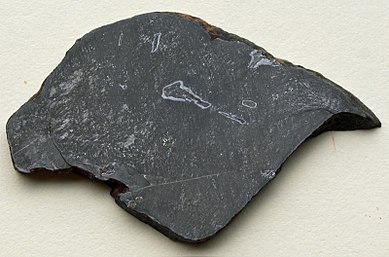Featured Image: A sample of the mineral schreibersite, a possible source of meteoric phosphorus. CC-BY 3.0, via Wikimedia commons.
Paper: Phosphorus mineral evolution and prebiotic chemistry: From minerals to microbes
Authors: Craig R. Walton, Oliver Shorttle, Frances E. Jenner, Helen M. Williams, Joshua Golden, Shaunna M. Morrison, Robert T. Downs, Aubrey Zerkle, Robert M. Hazen, Matthew Pasek
With a swift strike, a match bursts into flame. Life, like the flame, burst into existence almost 4 billion years ago, and as with the sparking of the match, phosphorus was a key ingredient. Phosphorus, element 15, is at the center of energy production in cells, forms cell walls, and provides the backbone for DNA.
Researchers studying the origins of life develop mixtures to simulate conditions on early Earth that might have led to life. However, the Earth has changed drastically since, which makes it hard to pinpoint what materials were available. A new review from the University of Cambridge attempts to determine which phosphorus minerals were present at the time of life’s origin, making them possible agents in creating the world we know today.
Recreating the mineralogy of billions of years ago is extremely difficult, because not much information survives to this day. The authors reviewed the rare samples that did survive, looking for which phosphorus minerals were present. However, these ancient samples had been through weathering and other changes, which can alter the minerals inside them. Because of these limitations, the authors also studied phosphorus in meteors. Early Earth experienced heavy meteor bombardment from its formation through the likely time of early life, which means meteors could have been a source of phosphorus. They found a high concentration of schreibersite, Fe3P, in the meteors, in addition to a large amount of apatite, which is the most common phosphorus mineral today. Schreibersite is rare at the surface of the Earth today, because it rapidly oxidizes. However, before life, there was very little oxygen in the atmosphere, so it could feasibly have accumulated on early Earth.
In addition to studying ancient samples and meteors, the authors used modeling and logic to further narrow the list of relevant minerals for pre-life chemistry. The Great Oxygenation Event, when life began to produce oxygen around 2.5 billion years ago, led to enormous increases in atmospheric oxygen levels. This led to many new minerals, but also new ions, such as iron (III) instead of only iron (II). They used this to rule out any minerals with both iron (III) and phosphorus, since they couldn’t have existed at the time. They also reviewed research about early tectonic environments, to consider which minerals would be associated with which models. Because there are so many unknowns, they offered several tectonic scenarios, so that other researchers can consider the environments near where they predict the origins of life, and choose minerals based on what could be found there.
Between their analyses of meteoric phosphorus, rocks more than 3.5 billion years old, and the geologic conditions of early Earth, the authors conclude that there are three broad scenarios. The first is that the primary source of phosphorus was apatite. Apatite’s insolubility means it hasn’t been extensively studied, but they note that under the right pH and temperature, apatite can easily dissolve, and is therefore still worth considering. This scenario would occur if continental crust similar to that found today formed very early on. If, instead, the early continents had compositions like that of modern oceanic crust, they wouldn’t have been able to form apatite. In this second scenario, the phosphorus would come from trace amounts in olivines, iron-magnesium silicate minerals, which while not ordinarily high in phosphorus, would have been the best source available. The third scenario depends on schreibersite, either from random meteoric impacts or formed on Earth from extremely low-oxygen magmas. Schreibersite and similar forms of phosphorus have been found participating in biochemistry-like processes in the past, which makes this scenario particularly intriguing.
In the end, knowing the precise conditions that led to life is likely impossible. However, narrowing the possible scenarios helps refine our understanding of where we came from and how our planet has evolved. Phosphorus is one small piece of that puzzle, but one that offers a lot of clues for further investigation.
Hunting for phosphorus on early Earth by Sean Boyce is licensed under a Creative Commons Attribution-ShareAlike 4.0 International License.

